Bennvdm
Active member
Not 100% related to the topic at hand, but hereis an flash AF assist llight article that also appears to confirm that Canon dual pixel AF has pdaf sensors on all pixels whilst nikon and sony is only on green & blue

 www.dpreview.com
www.dpreview.com
edit - add 2nd Neil van Niekerk link with A1 vs D5 low light event Comments.

 neilvn.com
neilvn.com
Even with dual pixel af Canon R5 also has issue with flash Af assist light, as dslr had no ir cut filter on af module sensor, only on sensor, but as AF is on image sensor on mirrorless, this is after IR filter. Majority of AF assist light is IR, so therefor no visible to human eye and mirrorless.

The essential pro feature that no mirrorless camera offers
The inability of mirrorless cameras to fire flash AF illuminators means they can't compete with DSLRs for critical shooting in low light. Manufacturers need to find a solution.
edit - add 2nd Neil van Niekerk link with A1 vs D5 low light event Comments.

Finding a solution for poor low-light auto-focus with mirrorless cameras - Tangents
Finding a solution for poor low-light auto-focus with mirrorless cameras As much as I love all the advantages mirrorless cameras offer, at this point there is still a serious flaw in my experience – the low-light autofocus response just isn’t as solid as the top-end DSLRs. The autofocus...
Even with dual pixel af Canon R5 also has issue with flash Af assist light, as dslr had no ir cut filter on af module sensor, only on sensor, but as AF is on image sensor on mirrorless, this is after IR filter. Majority of AF assist light is IR, so therefor no visible to human eye and mirrorless.
Last edited:

